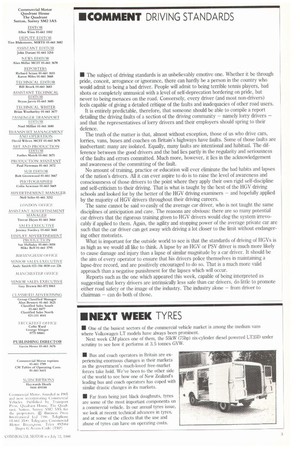111COMMENT DRIVING STANDARDS • The subject of driving standards is
Page 5

If you've noticed an error in this article please click here to report it so we can fix it.
an unbelievably emotive one. Whether it be through pride, conceit, arrogance or ignorance, there can hardly be a person in the country who would admit to being a bad driver. People will admit to being terrible tennis players, bad shots or completely unmusical with a level of self-deprecation bordering on pride, but never to being menaces on the road. Conversely, every driver (and most non-drivers) feels capable of giving a detailed critique of the faults and inadequacies of other road users.
It is entirely predictable, therefore, that someone should be able to compile a report detailing the driving faults of a section of the driving community — namely lorry drivers — and that the representatives of lorry drivers and their employers should spring to their defence.
The truth of the matter is that, almost without exception, those of us who drive cars, lorries, vans, buses and coaches on Britain's highways have faults. Some of those faults are inadvertant: many are isolated. Equally, many faults are intentional and habitual. The difference between the good drivers and the bad lies partly in the regularity and seriousness of the faults and errors committed. Much more, however, it lies in the acknowledgement and awareness of the committing of the fault.
No amount of training, practice or education will ever eliminate the bad habits and lapses of the nation's drivers. All it can ever aspire to do is to raise the level of awareness and consciousness of those drivers to the point where they apply their own rigid self-discipline and self-criticism to their driving. That is what is taught by the best of the HGV driving schools and looked for by the better of the HGV driving examiners — and hopefully applied by the majority of HGV drivers throughout their driving careers.
The same cannot be said so easily of the average car driver, who is not taught the same disciplines of anticipation and care. The reasons are obvious: there are so many potential car drivers that the rigorous training given to HGV drivers would clog the system irrevocably if applied to them. Again, the agility and stopping power of the average private car are such that the car driver can get away with driving a lot closer to the limit without endangering other motorists.
What is important for the outside world to see is that the standards of driving of HGVs is as high as we would all like to think. A lapse by an HGV or PSV driver is much more likely to cause damage and injury than a lapse of similar magnitude by a car driver. It should be the aim of every operator to ensure that his drivers police themselves in maintaining a lapse-free record, and are positively encouraged to do so. That is a much more valid approach than a negative punishment for the lapses which will occur.
Reports such as the one which appeared this week, capable of being interpreted as suggesting that lorry drivers are intrinsically less safe than car drivers, do little to promote either road safety or the image of the industry. The industry alone — from driver to chairman — can do both of those.




















































































